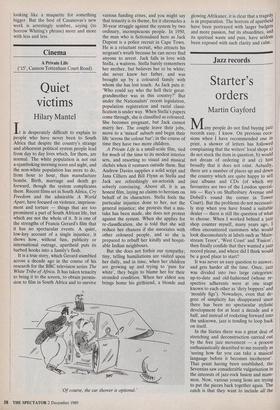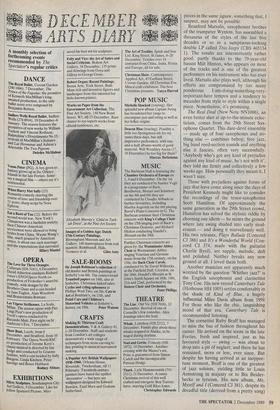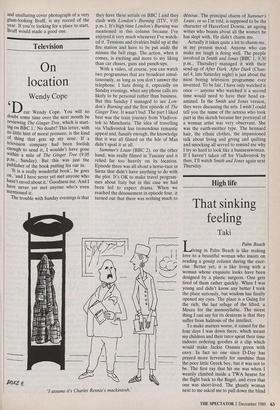Jazz records
Starter's orders
Martin Gayford
Many people do not find buying jazz records easy, I know. On previous occa- sions when I have recommended one in print, a shower of letters has followed complaining that the writers' local shops a) do not stock the item in question, b) would not dream of ordering it and c) hint broadly that it does not exist. Actually, there are a number of places up and down the country which are quite happy to sell jazz albums and CDs (of which my favourites are two of the London special- ists — Ray's on Shaftesbury Avenue and Dobell's round the corner in Tower Court). But the problems do not necessari- ly stop when you have found a suitable dealer — there is still the question of what to choose. When I worked behind a jazz shop counter myself, many years ago, I often encountered customers who would look disconsolately at labels such as 'Main- stream Tenor', 'West Coast' and 'Fusion', then finally confide that they wanted a jazz record please, and where did I think would be a good place to start?
It was never an easy question to answer, and gets harder all the time. Once, jazz was divided into two large categories: up-to-date and old-fashioned (whose re- spective adherents were at one stage known to each other as 'dirty boppers' and `mouldy figs'). Nowadays, even that de- gree of simplicity has disappeared since there has been no spectacular stylistic development for at least a decade and a half, and instead of rocketing forward into the unknown, jazz is tending to loop back on itself.
In the Sixties there was a great deal of stretching and deconstruction carried out by the free jazz movement — a process enthusiastically described to me recently as `seeing how far you can take a musical language before it becomes incoherent'. That point having been established, the Seventies saw considerable vulgarisation in the interests of jazz-rock fusion and mam- mon. Now, various young lions are trying to put the pieces back together again. The catch is that they want to include all the pieces in the same jigsaw, something that, I suspect, may not be possible.
Branford Marsalis, saxophonist brother of the trumpeter Wynton, has assembled a thesaurus of the styles of the last five
decades or so in a sumptuous-looking double LP called Trio Jeepy (CBS 465134
1). The results are intermittently rather good, partly thanks to the 79-year-old bassist Milt Hinton, who appears on most of the tracks and is one of the greatest performers on his instrument who has ever lived. Marsalis also plays well, although his efforts are compromised by too many ponderous I-am-doing-something-very- important-here tempos and a tendency to meander from style to style within a single piece. Nonetheless, it's promising.
The Real Deal (New Note NN1006), an even better shot at up-to-the-minute eclec- ticism, comes from the 29th Street Sax- ophone Quartet. This dare-devil ensemble — made up of four saxophones and no- thing else — combines bebop, free jazz, big band reed-section sounds and anything else it fancies, often very successfully. `Anybody who's got any kind of prejudice against any kind of music, he's not with it', they told me firmly and collectively a few weeks ago. How personally they meant it, I wasn't sure.
Those with prejudices against forms of jazz that have come along since the days of President Kennedy might like to consider the recordings of the tenor-saxophonist Scott Hamilton. Of approximately the same generation as the 29th Street crowd, Hamilton has solved the stylistic riddle by choosing one idiom — he mines the ground where late swing shaded into early mod- ernism — and doing it marvellously well. His two releases, Plays Ballads (Concord CJ 386) and It's a Wonderful World (Con- cord CJ 374, made with the guitarist Charlie Byrd), are supple, melodic, deft and polished. Neither breaks any new ground at all. I loved them both.
Another musician not apparently much worried by the question 'Whither jazz?' is the English saxophonist and clarinettist Tony Coe. His new record Canterbury Tale (Hothouse HH 1005) settles comfortably in the shade of Kind of Blue, a hugely influential Miles Davis album from 1959. For those who like the chic, languishing mood of that era, Canterbury Tale is recommended listening.
The cornettist Ruby Braff has managed to miss the bus of fashion throughout his career. He arrived on the scene in the late Forties, fresh and inspired, just as his favoured style — swing — was about to drop into a pit of neglect; and there he has remained, more or less, ever since. But despite his having arrived at an inoppor- tune moment, Braff is one of the greatest of jazz soloists, yielding little to Louis Armstrong in majesty or to Bix Beider- becke in lyricism. His new album, Me, Myself and I (Concord CJ 381), despite its dreadful title (derived from a pretty song) and unalluring cover photograph of a very glum-looking Braff, is my record of the year. If you're looking for a place to start, Braff would made a good one.












































































 Previous page
Previous page